Motivation is our fuel to accomplish our projects, achieve our goals, and do it all with enthusiasm. Naturally, when we lose it, we feel completely overwhelmed.
But how can we still draw and continue to progress when we have lost all interest? Rest assured, there are tricks to regain it and adopt a serene and enthusiastic mindset more easily.
We will go through eight important points that, when combined, will help us regain that sports mentality we want to develop to progress in drawing. Let’s get started!
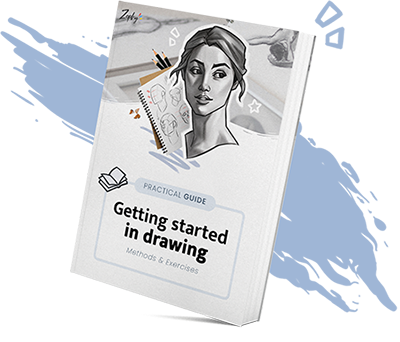
Discover our free guide to start drawing easily. You will learn practical methods and exercises to put into practice right away.
1 - Demotivation is a natural phenomenon
We tend to feel down when we lack motivation or the desire to make progress on a project or goal we have set for ourselves.
Typically, this demotivation is accompanied by a lack of energy and a decrease in morale. We lose interest in everything, and find ourselves caught in a vicious cycle without knowing how to break free from it.
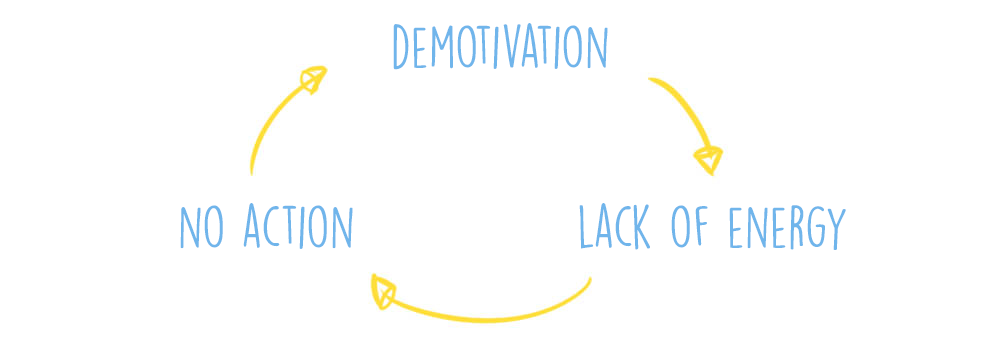
Motivation is nothing more than a mood
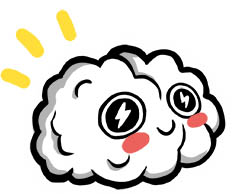
Motivation is not constant, it’s like a mood that changes depending on the days, the environment, and what is happening in your life at the moment.
Losing motivation is a natural and inevitable phenomenon. We all go through it, and it’s the first idea to accept: no, we cannot be at our best every day of the year. We cannot be super productive and energetic every day of the week. And that’s completely okay!
Some mornings, you will wake up super motivated, ready to tackle a busy day, ready to take on and accomplish many things. Then, on other mornings, you will just want to roll up in your blanket and stay cozy in bed, with the desire to do nothing.
Accepting that there are days without motivation

The first step is to recognize the days when we are demotivated and to accept it. To accept that there are days without motivation and not to feel guilty about experiencing that mood.
But in order not to give up, to successfully carry out the projects that are dear to us, the key is to learn to manage this mood and work with it rather than against it.
2 - Remember the reason why you started in the first place
The best method to regain some willpower is to remember why you had it in the first place. Recall the reason why you decided to learn how to draw.
There can be several reasons: to prove yourself (or prove to others) that you are capable, to pursue a career that you are passionate about, for pure relaxation, or the desire to create more believable characters.

As we saw in the article “The 5 Mistakes Beginners Make in Drawing” the first mistake is not defining your “why.” This step is crucial to avoid getting discouraged and to have a direction to follow.
Human beings need clear and defined goals to have a direction to follow. Motivation may fluctuate, but the reason why you want to progress in drawing will remain constant.

By recalling this reason every time you lose motivation, you will find that your desire to continue is stronger than your demotivation. You will even draw on days when you don’t feel fully motivated!
If you haven’t found a compelling reason to invest yourself in drawing yet, it’s time to find one! Without a real reason to commit, you run the risk of losing motivation along the way.
📌 Quick exercise to do
1
Identify what you enjoy about the act of drawing
Is it the act of sitting down with paper and engaging in something manual and creative? Or do you enjoy exploring new digital techniques to inspire you? Is it the ability to visually bring to life the worlds you imagine?
2
Try to understand what you feel when you draw
Is it calmness? Joy? Pride? Impatience to improve? Generally, the emotion that arises is positive. Understanding your feelings is essential to tap into them on the days when motivation is lacking.
3
What level do you want to achieve in drawing, and why?
What do you aim to accomplish by improving? What do you plan to do with all the skills you master? Take a moment and visualize yourself reaching the drawing level you dream of.
4
Write down your answers on a sticky note
Write down everything you have previously defined on paper. The idea is to remember how you feel when drawing and everything you want to achieve by improving. When you experience demotivation, read this little note and remind yourself why you want to draw in the first place.
3 - Reassess your priorities and your time management
Of course, there are various other obstacles to your motivation. If you lack time or have busy days, it can be challenging to find the time to engage in drawing. It’s easy to feel overwhelmed and discouraged.
However, this obstacle can be overcome by setting priorities and organizing your time according to your own life. It’s not necessary to allocate 2 hours for drawing every day if your schedule is already packed.
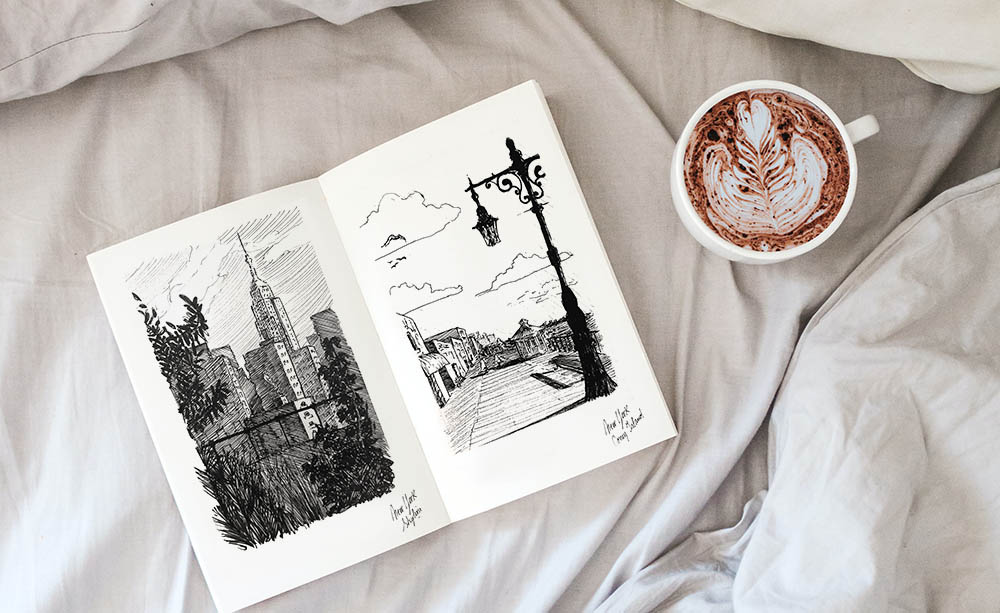
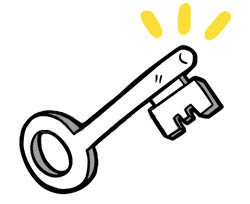
The key to drawing is consistency. If you have only one drawing session of about 3 hours per week, it will be less effective in terms of progress compared to having a 10-minute drawing session every day.
The process I use to avoid feeling overwhelmed and to keep making progress despite the lack of motivation is to schedule my own drawing sessions!
It’s like making an appointment with yourself. Commit to keeping these appointments, even if it’s just for the duration of a coffee break.
In general, by organizing ourselves better, we can easily regain motivation. The key is to find the type of organization that works best for you.
For example, when I used to create a long to-do list for the day, I realized that I ended up not doing anything because I felt overwhelmed. Drawing was completely neglected! However, when I started defining time blocks with small tasks to accomplish one at a time, it was a relief.
By setting a daily drawing routine of 20 to 30 minutes at 6 PM, with a small theme that I pre-defined, I couldn’t wait for the end of the day to have fun drawing!
My motivation automatically returned because instead of thinking, “Today, I have to do a portrait,” I would say to myself, “From 6 PM to 6:30 PM, I’m just going to learn how to draw a nose.”
Being more specific and concise made me feel less demoralized by the magnitude of the task.
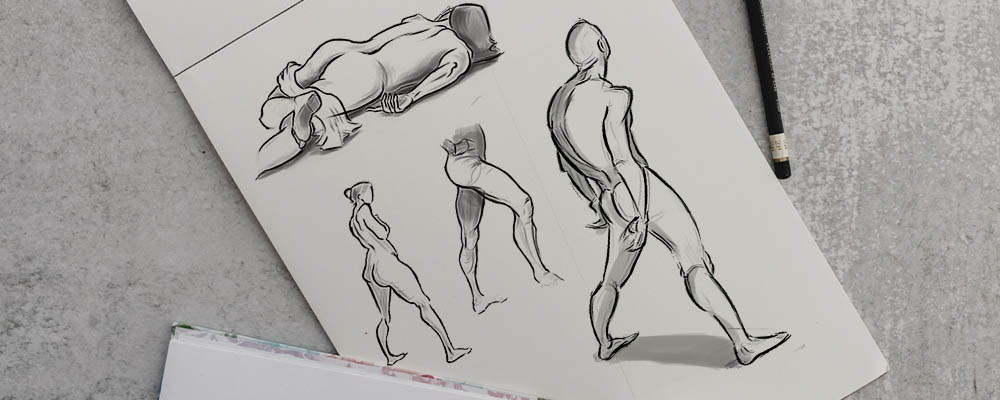
Studies from Hampton’s and Mattesi’s books
The organizational process
1
We think about the desired outcome. For example, drawing a portrait.
2
We plan our week by setting up drawing sessions. For example, every day from 6:00 PM to 6:30 PM.
3
We break down our goal of creating a portrait into specific tasks and sub-tasks. For example, we dedicate Monday to head construction, Tuesday to proportions, Wednesday to shading, and so on.
4
Now we just need to take action, no more need to overthink, everything is already organized! Seeing that the tasks are simple, it becomes less anxiety-inducing, and we can continue to make progress while enjoying the process.
4 - Creating a stimulating environment for yourself
Time is not the only thing to manage, the environment is also super important. Who would feel like drawing in a completely messy room?
A tidy and organized room allows the brain to not focus on a hundred things and not get scattered.

So take the time to set up your materials properly and remove as many items as possible from your desk or the table where you’ll be drawing. The idea is to have as few visual distractions as possible!
Beyond just tidying up, it’s important that you truly feel comfortable in your drawing space. It could be as simple as adding some decorative elements or even rearranging the desk altogether.
Working from home, I had to change the placement of my desk about ten times before finding the ideal spot where I feel more productive, calmer, and therefore more motivated.
Before starting a drawing session, I take the time to tidy up everything and play my best playlist of motivating music!
Motivation can fade as quickly as it comes, so each element has its importance in maintaining it for as long as possible. The environment also plays a role and can be a source of discouragement.
It is important for you to associate drawing with a moment of pleasure and serenity, so start by making your workspace as enjoyable as possible.
5 - Take back control
When we are demotivated, it is often difficult to find the will to overcome this mood. We let ourselves be overwhelmed by it, and we eventually give up after struggling against it.
But see this as an opportunity to work on your willpower! By allowing ourselves to be controlled by our emotions and moods, we absolve ourselves of responsibility and lose complete control.
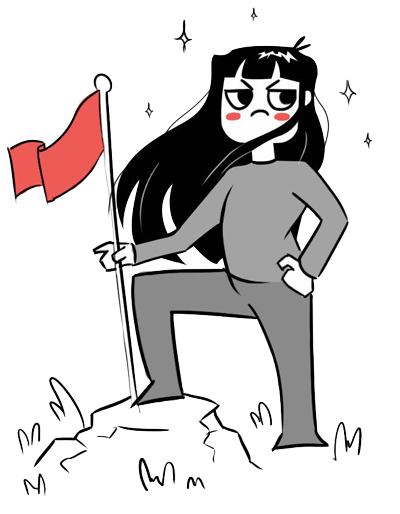
Succeeding in accomplishing something despite the lack of desire is actually a result of discipline and consistency.
By pushing yourself to change your habits and not giving up in the face of demotivation, you ultimately limit its occurrence.
Athletes may not always feel like training every day. They also experience moments of laziness, low morale, or lack of energy.
What keeps them progressing is their ability to show up for training regardless of their mood. By taking immediate action, they automatically feel proud of themselves.
They have overcome that inner voice telling them they didn’t want to go! If their goal is to gain muscle mass, for example, they have made their goal a priority.
📌 The 10-Minute Method
Try this little exercise if you don’t feel like drawing, if you’re not in a great mood, or if you feel discouraged.
Decide to embark on the task you want to accomplish, despite the lack of motivation, just for 10 minutes.
Give yourself just 10 minutes, despite the lack of desire, try to start your tree drawing for these few minutes. The first step is the hardest, and once that step is taken, the demotivation fades away because we have taken action!
After 10 minutes, take a moment to evaluate your progress.
If after 10 minutes you still feel demotivated, you can stop. You have still completed a short session, and you can already be proud of that!
If, on the other hand, now that you have started, you want to continue, congratulations! You have just reprogrammed your mindset in just 10 minutes.
Taking action is the key.
By forcing ourselves to take action, we reprogram our mindset to no longer give up in the face of demotivation. Over time, this becomes highly beneficial as we develop habits to counter the lack of motivation.
As a reflex, we will take action to overcome this lack of energy, leading us back to a virtuous cycle. Only the act of getting started may seem difficult, but once we’re in motion, everything usually falls back into place.
6 - Valorize your progress

When tackling a project that is important to us and we fail to achieve the desired result, discouragement can quickly set in. Instead of starting over, we may be tempted to give up and think, ‘Oh well, never mind.’
But what if we looked at the glass as half full rather than half empty? Maybe your drawing isn’t as good as you wanted it to be, but hey, you’re still learning, and the next one will be even better!
Due to the negativity bias, we tend to overlook the positive things around us. Take the time to celebrate each of your victories and each of your progressions.
With every drawing session I complete, I take the time to note the good things that came out of it. I jot down what I’ve learned and the next areas to improve. Focusing on failure will never allow you to find motivation.

If you self-criticize every time, it’s like rewarding your brain by telling it that it’s no good when it tries to undertake something. Naturally, over time, it doesn’t even feel like trying anymore.
Take the time to acknowledge and celebrate your progress, accomplishments, and achievements. By recognizing how far you’ve come, you’ll be filled with a sense of pride, and you can! Be genuinely happy with what you’re doing, and you’ll feel the motivation resurfacing.
7 - Finding motivation in others
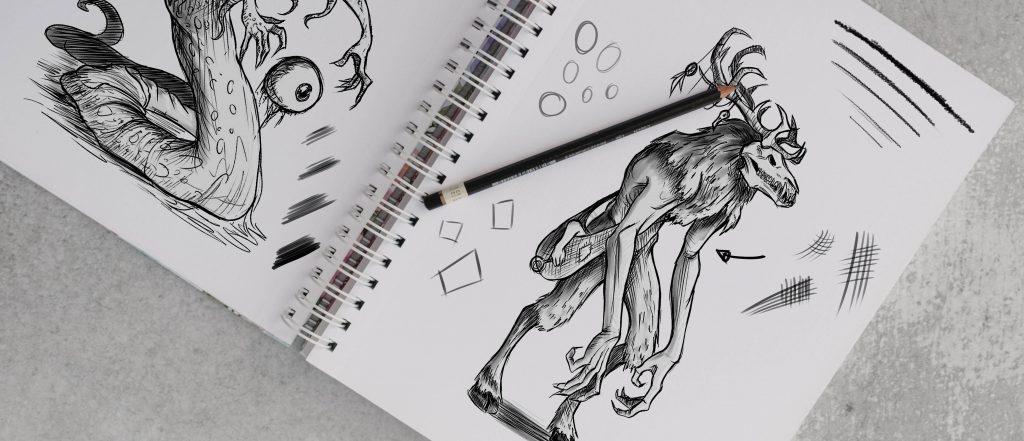
You don’t have to go through this phase of demotivation alone! Draw inspiration from others and feed off their energy to regain your own.
Sometimes, demotivation stems from a simple lack of inspiration. We no longer feel stimulated, our field of vision feels narrowed. We no longer have clear drawing ideas and we’re unsure of what to do next.
When that happens to me, I immerse myself in the inspiring stories of people who started from nothing and have become accomplished artists today. Find that little boost of motivation that gives you a glimmer of hope when you feel stuck in that mood.
The best way to regain motivation is also to have a partner with whom you can exchange your progress in drawing, your frustrations, and your fears.
Having someone who shares the same desires and goals as you can inspire you on a daily basis. The discussions will make you come alive, and you will become each other’s support when you lose that motivation.
Finally, don’t forget the importance of music! A simple uplifting song can help put a smile on your face, make you want to dance, and get you into a more joyful state of mind!
8 - Taking real moments of rest
The last point seems essential, but is sometimes forgotten. It is essential to give yourself real downtime, moments where you disconnect from everything.

It is truly necessary to allow yourself moments of entertainment to clear your mind and relax, without any performance or progression goals. By truly resting, you can only come back with renewed energy!

Accept the fact that sometimes motivation will only return after a good night’s sleep. So let go for the evening and rid yourself of any guilt. If you can’t make progress tonight, it’s okay. You can try again tomorrow.
Sometimes, we become so stressed that we completely neglect ourselves. We stop taking care of ourselves and relentlessly strive to be productive.
Our body and mind are on high alert and can’t seem to activate the “Stop” button. Take the time to recharge your batteries.
Take a short break from drawing, change your surroundings, and you’ll find that you’ll come back even more energized and motivated.
To conclude
We have all experienced this loss of motivation. It is not easy to deal with and can feel like it never wants to leave once it sets in.
Fortunately, the 8 tips we discussed help minimize it and even prevent it from occurring as frequently. To recap:
- Understand that demotivation is a natural phenomenon.
- Remember why you started.
- Readjust your priorities and your time.
- Create a stimulating environment for yourself.
- Take back control.
- Celebrate your progress.
- Seek motivation from others.
- Give yourself real moments of rest.
Do you also find yourself using little tricks to overcome this loss of motivation when it comes to drawing? ✍️
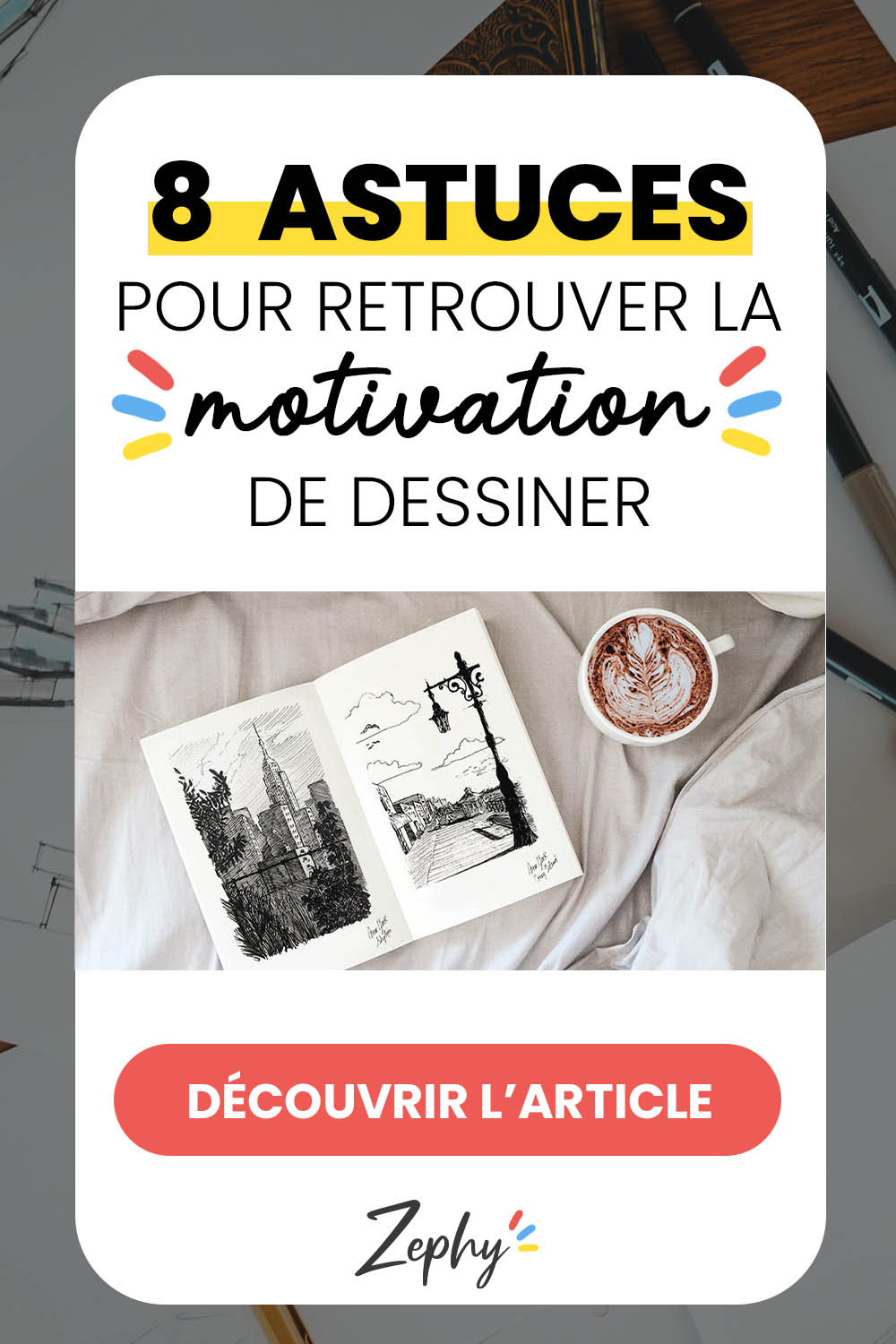

Save the article for future reference!
By hovering over the image, you can directly save the article to your Pinterest account. This also allows us to share the article with a wider audience of aspiring artists!
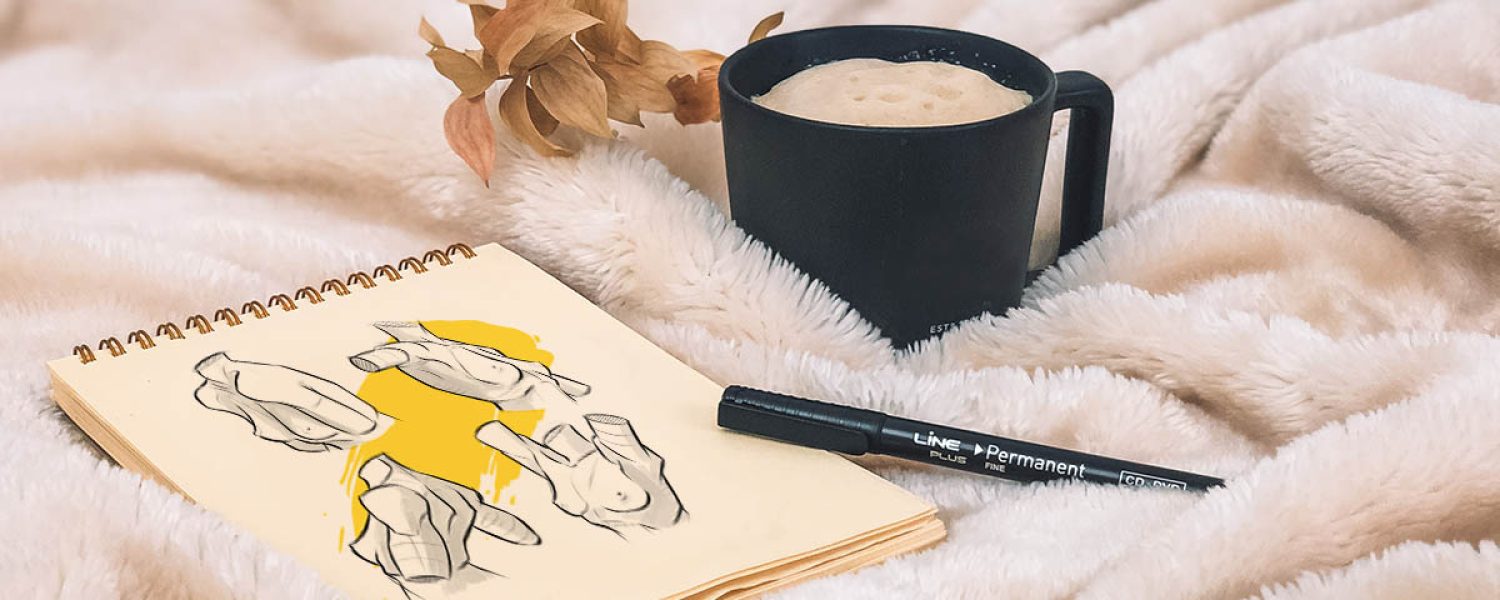



8 comments
“Great article, it always feels good to reread simple yet effective principles. I also love how you organize all your different paragraphs and other elements (like post-it style). Looking forward to the next one, so get to work Zephy 😉
Ooh thank you Guillaume for your always positive and encouraging feedback! ✨ I’m glad you like both the content and the style. Yes, let’s get started on the next one!
I will testify about my experience on this subject, fresh in my mind. I was in a state of extreme demotivation: I wanted to learn the fundamentals for 10 years, but I couldn’t find the motivation to do so (and learning these fundamentals isn’t fun). Drawing has always been a source of pain for me, yet I kept coming back to it. My goal was to create a comic book, but even that goal didn’t inspire me. I took a drawing course hoping it would motivate me, but it had the opposite effect, even though it laid the groundwork for me to truly want to learn. But it wasn’t enough; there was no juice, no fuel, just emptiness.
I was on a website that offers challenges, challenges that I liked to watch, but I refused to participate due to my skill level… you get the idea. The challenge consists of a theme, a subject, studied over a week (around 7 panels), leading to a final illustration.
A man pushed me from behind, literally. He was a very kind person, rare to find in the world. Several times, he encouraged me to try, gave me resources to learn how to write stories, but I didn’t do anything with them; in fact, I felt like I was forcing myself. He tried at least 5 times. He didn’t give up, and that impressed me. He tried to get me to post my drawings, which I didn’t want to show anyone, especially my favorite character (he spotted me because I was asking questions on a Discord chat). One day he insisted, saying that the challenge’s theme was precisely my strong point (thus showcasing my favorite character) and that it was what I loved most. Even so, I didn’t do it.
A few days later, another member said something in the Discord chat that struck me to the core (related to this subject). In the end, piqued like a fly, I dared to do this famous challenge, and I put all my heart into it. Then, I wanted to quit, but the kind man pushed me again. I wasn’t inspired by the theme, but he managed to get me to look beyond and gave me hints, always using that same character. And I kept going. To my horror, I discovered that the themes I thought I hated were the ones that brought me the most joy, and the ones I thought would bring me joy… were an infinite torment.
From that moment on, things “clicked,” even though two of those challenges almost pushed me to quit. The current challenge has made me face my shortcomings in drawing, so I decided to acquire the fundamentals and do these challenges “properly” (because I don’t know how to study my subjects, as I have a lot of trouble retaining what I learn, but I’m trying and I bless Zephy’s article on how to overcome mental blocks because it talks about how to study properly, and it finally clicked for me!). These challenges will resume in September. So, due to this specific timing, I feel a sort of “pressure” to acquire these fundamentals (in 3 months), or else I’ll have to do these challenges again with my mediocre skill level, which I don’t want (because knowing myself, I’ll still want to do them). So one key is pressure, but pressure for something you love. And if you’re really desperate and say, “I don’t know what I love,” if you’re truly stuck, you can pray to God with all your might, it might work XD.
Having a character I love, that I want to be able to draw, also helps a lot to propel me forward because without him, I wouldn’t have been able to do these challenges. For example, a girl in my class kept drawing Naruto’s faces, and well, I have the same syndrome, but worse, because abandoning him literally destroys me and destroys any desire to learn these fundamentals.
I can tell you that I’m a special case, as I have a fear of living to the point where I dare nothing, let alone experiment in life or “let myself live” (a deep rejection wound that makes me refuse to learn to “embody myself in this world”). So if the dough rose for me, why not for you (even though I’m a bear cut off from the world)? In short, I want to encourage those who feel really down in the dumps.
Sorry for the length, but as I myself seek this type of sincere testimony, I’m sharing it with others. Cot cot!
Thank you, Laura, for your testimony; it’s very touching, and I hope you won’t put too much pressure on yourself. Pressure can be a driving force, but it can also paralyze; it’s a delicate balance to find, and it’s not easy. In any case, don’t be afraid to “do it wrong,” even with these challenges. Because each challenge will be a source of learning, and you will progress each time, even if it’s not yet at the level of what you’d like to create. The important thing is to enjoy it. And in 3 months, if we stick to it every day, we are capable of achieving beautiful results. ✨
Many thanks for this timely article! Totally encouraging and very well-structured! I will put all of this into practice 🙂
Hello Alice, with great pleasure. I’m delighted that it can help and encourage you, happy drawing to you! ✨
Great article, thank you, I wouldn’t have thought of some tricks! Clearly, in my case, there is a blockage partly due to the fact that drawing became compensation for a failed life in other aspects, which distorted the initial motivation and turned it into a positive feedback loop that I became dependent on. Additionally, nowadays, everyone draws, which can be very destabilizing and anxiety-inducing when one is already self-conscious about other things, making us feel that not only are others not bad at drawing, but they can do the same things as us, if not better.
However, this can be overcome, and creativity is always stimulating. In fact, the thing that blocks me, besides being literally overwhelmed by daily worries, which are not all sources of inspiration, especially when one is not a humorist :p, is THE SETTING. As you mentioned, a stimulating environment is essential; for me, it’s the foundation, it’s VITAL, and mine is consuming me, even though I’ve done my best to address it. There’s no practical place to fit a table, no comfortable spot to sit with a sketchbook and pens, let alone enough space on the table to doodle on a draft, it’s very dark, it feels like being at the agriculture museum, Kenny’s version in a touristy bourgeois town, it needs a good coat of paint, it’s more draining than refreshing, impossible to move or even empty the place for renovation, besides it’s not mine, the lighting issue is not simple, in short, I’m stuck on this and I’m even considering psychotherapy to be able to draw in this place because, even if it’s improved to the best, I have an increasing obsession with it. The lockdown affected us all; I’m surely not the only one! If someone from my circle could give me a kick in the ass, it might help, but we are often alone in this matter. (As for sharing online, the strange mix of compliments and silence: very few responses, which resulted in more discouragement than anything else, hence digital detox, as it brings back the pressure of revenge on mistakes, failures, and frustrations, and soon enough, age since more than half of those who have visibility are considerably younger than me.
The idea of revisiting what motivated us to start is brilliant; my solution could lie somewhere there. Thank you for these tips 🙂
PS: The idea of drawing inspiration from those who started from scratch is excellent. Some time ago, I started including biographies in my readings in this regard. (It helps a lot to realize that we are not the only ones struggling in the doldrums). These are really great tips, you have a good understanding of the subject, and I already feel much more prepared!